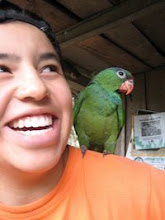It’s my last week in Ecuador, I left the bear project last Sunday morning, spent a night in Quito and then went on one final short trip to Baños. This little town, located in central Ecuador, is known for the hot springs that give it its name, adventure sports and nearby volcano Tungurahua. Currently Tungurahua - literally “fire-throat” in Quichua – is in the process of erupting. So I went to go see it.
In recent news, Tungurahua expelled a lot of ash and lava, covering its leeward side and forcing the evacuation of many resident campesinos and farmers on that side. As far as I know, no people were physically harmed, but unfortunately many livestock got into trouble. I don’t know what options are available to the residents of all the high-risk areas – whether they have somewhere to go to, or what they are going to do now that their land and homes have been destroyed. Seems like a pretty tough situation to be in. So far Baños has been unaffected by the recent eruptions due to it being situated on the other side of the volcano. The bus ride and generally clear skies made it easy for me to see the impressive destruction all over the mountain’s side. It was completely covered in ash, looked like a river of gray had flooded upon it. During the day clouds generally cover the summit of the volcano, but a huge gray cloud of ash billowing upwards rose out of the mist, visible from quite far away. In order to see the actual lava flow one needs to look at night, so after wandering around town, getting a room, going for a little walk up a nearby hill, and eating, I found myself on a “chiva” bus – an open truck designed for transporting tourists around the area. We rode up the opposite side of the valley and from here we could see the mountain outlined quite well. Our guides told us that we were approximately 5 km from the top. Since the crater seems to be facing away from the Baños side, we could see some flames rising up and occasionally lava rolling down on the horizon, like bright red moving sparkles. We had been watching for a little while when suddenly the volcano erupted. It’s a pretty hard phenomenon to describe. First of all it was pretty unexpected. Suddenly there was this puff of redness, and a huge bright red cloud shot upwards. Glittering pieces of lava rose with it and seemed to hang in the air for a long breathtaking moment. Then they covered the entire face of the mountain, making it glow like it was on fire. A deep rumble shook the air. It sounded a lot like thunder.
After that I don’t know if I expected the rest of the trip to compare to that moment, but white water rafting was another definite highlight. The next day I found myself soaking wet and paddling like crazy as our raft swayed from side to side on the Rio Pastaza. The trip took us East, away from Baños to the area around the town of Puyo – the beginnings of the rainforest. I ended up with a big group of tourists, split up on two rafts, each with its own guide who barked out rowing commands: ‘forward’, ‘stop’, ‘backwards’, ‘right backwards’, ‘left backwards’, and my personal favorite ‘inside’, where we all huddled towards the center so we wouldn’t fall out in situations when impact with rough waves or shallow waters was expected. We had a couple of close moments in the water when I though the raft was going to capsize, but luckily that didn’t happen and only two people fell out who were quickly recovered. The other raft wasn’t so lucky: one minute it was upright and the next it was upside down and its occupants were in the river. We had lunch in Puyo, and it was cool to see that town too. Considerably less touristy, seemed somewhat more sprawling than Baños, to me, and it felt a lot warmer too. The jungle was seeping in! The rest of my trip was spent hiking up to some nice viewpoints, walking around, eating big breakfasts and renting a quadbike for an hour, when I went to see a pretty waterfall.
I’m back in Quito now, only a couple more days to go. Just enough time to say goodbye to my homestay family, Aldemar and Xavier, as well as newfound relatives Anita Steinitz and company, who have been so kind to take me in for my last few days. It’s been great. I’m sad to leave South America but at the same time, happy that I will see my family soon. It’s too bad that I have 4 days in transit from Quito to Windhoek, but I suppose that will be another adventure.
